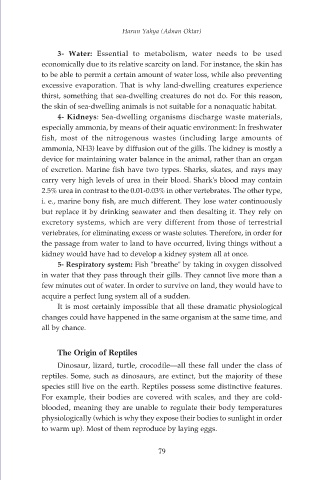Page 81 - Darwinism Refuted
P. 81
Harun Yahya (Adnan Oktar)
3- Water: Essential to metabolism, water needs to be used
economically due to its relative scarcity on land. For instance, the skin has
to be able to permit a certain amount of water loss, while also preventing
excessive evaporation. That is why land-dwelling creatures experience
thirst, something that sea-dwelling creatures do not do. For this reason,
the skin of sea-dwelling animals is not suitable for a nonaquatic habitat.
4- Kidneys: Sea-dwelling organisms discharge waste materials,
especially ammonia, by means of their aquatic environment: In freshwater
fish, most of the nitrogenous wastes (including large amounts of
ammonia, NH3) leave by diffusion out of the gills. The kidney is mostly a
device for maintaining water balance in the animal, rather than an organ
of excretion. Marine fish have two types. Sharks, skates, and rays may
carry very high levels of urea in their blood. Shark's blood may contain
2.5% urea in contrast to the 0.01-0.03% in other vertebrates. The other type,
i. e., marine bony fish, are much different. They lose water continuously
but replace it by drinking seawater and then desalting it. They rely on
excretory systems, which are very different from those of terrestrial
vertebrates, for eliminating excess or waste solutes. Therefore, in order for
the passage from water to land to have occurred, living things without a
kidney would have had to develop a kidney system all at once.
5- Respiratory system: Fish "breathe" by taking in oxygen dissolved
in water that they pass through their gills. They cannot live more than a
few minutes out of water. In order to survive on land, they would have to
acquire a perfect lung system all of a sudden.
It is most certainly impossible that all these dramatic physiological
changes could have happened in the same organism at the same time, and
all by chance.
The Origin of Reptiles
Dinosaur, lizard, turtle, crocodile—all these fall under the class of
reptiles. Some, such as dinosaurs, are extinct, but the majority of these
species still live on the earth. Reptiles possess some distinctive features.
For example, their bodies are covered with scales, and they are cold-
blooded, meaning they are unable to regulate their body temperatures
physiologically (which is why they expose their bodies to sunlight in order
to warm up). Most of them reproduce by laying eggs.
79

